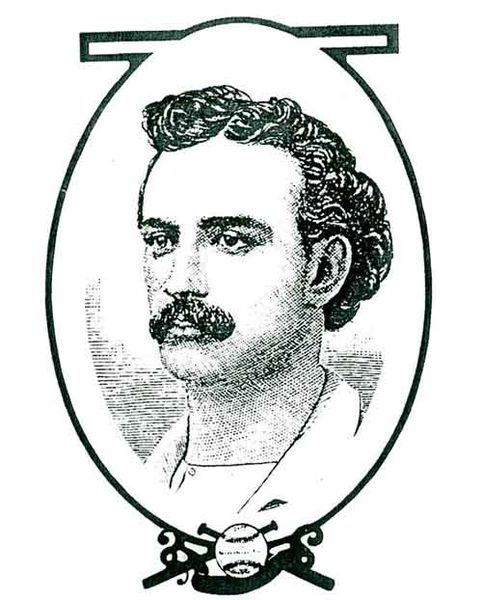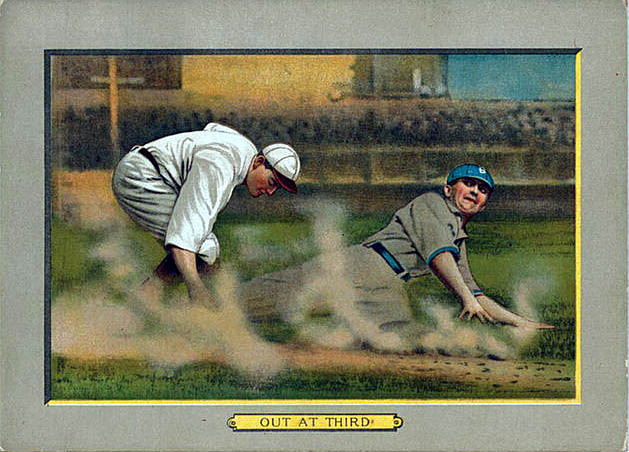|
Jim Creighton
James Creighton, Jr. (April 15, 1841 – October 18, 1862) was an American baseball player during the game's amateur era, and is considered by historians to be the sport's first superstar and one of its earliest paid competitors. In 1860 and 1862 he played for one of the most dominant teams of the era, the Excelsior of Brooklyn. He also was reputed to be a superb cricketer, and played in many amateur and professional cricket matches. During this early, pre-professional period of baseball's evolution, Creighton's pitching technique changed the sport from a game that showcased hitting, running, and fielding into a confrontation between the pitcher and batter. Under rules of the day, a pitcher was required to deliver the ball in an underhand motion with a stiff arm/stiff wrist movement. The intention was to induce the batter to swing and put the ball in play, thus initiating action on the diamond. Creighton's swift delivery was difficult for opposing batters to hit, beca ... [...More Info...] [...Related Items...] OR: [Wikipedia] [Google] [Baidu] |
Pitcher
In baseball, the pitcher is the player who throws ("pitches") the baseball from the pitcher's mound toward the catcher to begin each play, with the goal of retiring a batter, who attempts to either make contact with the pitched ball or draw a walk. In the numbering system used to record defensive plays, the pitcher is assigned the number 1. The pitcher is often considered the most important player on the defensive side of the game, and as such is situated at the right end of the defensive spectrum. There are many different types of pitchers, such as the starting pitcher, relief pitcher, middle reliever, lefty specialist, setup man, and the closer. Traditionally, the pitcher also bats. Starting in 1973 with the American League(and later the National League) and spreading to further leagues throughout the 1980s and 1990s, the hitting duties of the pitcher have generally been given over to the position of designated hitter, a cause of some controversy. The Japanese Central Le ... [...More Info...] [...Related Items...] OR: [Wikipedia] [Google] [Baidu] |
Relief Pitcher
In baseball and softball, a relief pitcher or reliever is a pitcher who enters the game after the starting pitcher is removed because of fatigue (medical), fatigue, ineffectiveness, injury, or ejection (sports), ejection, or for other strategic reasons, such as inclement weather delays or pinch hitter substitutions. Relief pitchers are further divided informally into various roles, such as Closer (baseball), closers, setup men, middle relief pitchers, left-handed specialist, left/right-handed specialists, and long relievers. Whereas starting pitchers usually pitch count, throw so many pitches in a single game that they must rest several days before pitching in another, relief pitchers are expected to be more flexible and typically pitch in more games with a shorter time period between pitching appearances but with fewer innings pitched per appearance. A team's staff of relievers is normally referred to Metonymy, metonymically as a team's bullpen, which refers to the area where th ... [...More Info...] [...Related Items...] OR: [Wikipedia] [Google] [Baidu] |
Brooklyn Atlantics
The Atlantic Base Ball Club of Brooklyn ("Atlantic" or the "Brooklyn Atlantics") was baseball's first champion and its first dynasty. The team was also the first baseball club to visit the White House in 1865 at the invitation of President Andrew Johnson. Era before league Established on August 14, 1855, Atlantic became a founding member of the National Association of Base Ball Players, the amateur sport's first governing body, in 1857. (There were no professional clubs at the time.) In 1859, with a record of 11 wins and 1 loss, Atlantic emerged as the recognized champions of baseball. Atlantic held the championship through the 1861 season, albeit in controversial fashion. In a third and deciding game with Excelsior of Brooklyn, Excelsior was leading 8–6 and had men on base, but was forced to withdraw by a rowdy crowd of Atlantic partisans and gamblers. The game was declared a draw, and the championship retained by Atlantic. Atlantic held the championship again through ... [...More Info...] [...Related Items...] OR: [Wikipedia] [Google] [Baidu] |
Jack Chapman
John Curtis "Jack" Chapman (May 8, 1843 – June 10, 1916) was an American Major League Baseball player and manager who was born in Brooklyn, New York. He began playing in the National Association when he played for the Brooklyn Atlantics and the St. Louis Brown Stockings. In , when the National League formed, he became the player-manager for the Louisville Grays. The following season saw him staying with Louisville in the manager role only. After the season, the Louisville team was expelled from the National League, and Chapman became manager of the Milwaukee Grays. The team had a poor record, and he was fired. In all, he managed 11 seasons in the majors, compiling a record of 351 wins and 502 losses, winning one championship in with the Louisville Colonels of the American Association. Chapman took part in the pre-modern era World Series by managing his team in the 1890 World Series, the seventh of eight held prior to the first modern Series in 1903. The team faced t ... [...More Info...] [...Related Items...] OR: [Wikipedia] [Google] [Baidu] |
John Lillywhite
John Lillywhite (born 10 November 1826 at Hove, Sussex; died 27 October 1874 at St Pancras, London) was an English cricketer and umpire during the game's roundarm era. John Lillywhite was part of a famous cricketing family, his father being William Lillywhite, a brother being Fred Lillywhite and his cousin being James Lillywhite. In 1863, members of the family established the sports outfitters Lillywhites. Lillywhite was an all-rounder who batted right-handed and bowled right-arm roundarm, both slow and fast. His known first-class career spanned the 1848 to 1873 seasons. He took 223 wickets in 185 matches @ 11.56 with a best analysis of 8/54. He took five wickets in an innings 12 times and 10 wickets in a match twice. He scored 5127 runs @ 17.43 with a highest score of 138, making two centuries. He took 94 catches. He served as cricket coach at Rugby School where he nurtured star all-rounder Tom Wills, one of the founders of Australian rules football. At the end o ... [...More Info...] [...Related Items...] OR: [Wikipedia] [Google] [Baidu] |
Cricketer
Cricket is a bat-and-ball game played between two teams of eleven players on a field at the centre of which is a pitch with a wicket at each end, each comprising two bails balanced on three stumps. The batting side scores runs by striking the ball bowled at one of the wickets with the bat and then running between the wickets, while the bowling and fielding side tries to prevent this (by preventing the ball from leaving the field, and getting the ball to either wicket) and dismiss each batter (so they are "out"). Means of dismissal include being bowled, when the ball hits the stumps and dislodges the bails, and by the fielding side either catching the ball after it is hit by the bat, but before it hits the ground, or hitting a wicket with the ball before a batter can cross the crease in front of the wicket. When ten batters have been dismissed, the innings ends and the teams swap roles. The game is adjudicated by two umpires, aided by a third umpire and match referee ... [...More Info...] [...Related Items...] OR: [Wikipedia] [Google] [Baidu] |
American Civil War
The American Civil War (April 12, 1861 – May 26, 1865; also known by other names) was a civil war in the United States. It was fought between the Union ("the North") and the Confederacy ("the South"), the latter formed by states that had seceded. The central cause of the war was the dispute over whether slavery would be permitted to expand into the western territories, leading to more slave states, or be prevented from doing so, which was widely believed would place slavery on a course of ultimate extinction. Decades of political controversy over slavery were brought to a head by the victory in the 1860 U.S. presidential election of Abraham Lincoln, who opposed slavery's expansion into the west. An initial seven southern slave states responded to Lincoln's victory by seceding from the United States and, in 1861, forming the Confederacy. The Confederacy seized U.S. forts and other federal assets within their borders. Led by Confederate President Jefferson Davis, ... [...More Info...] [...Related Items...] OR: [Wikipedia] [Google] [Baidu] |
Brooklyn Eagle
:''This article covers both the historical newspaper (1841–1955, 1960–1963), as well as an unrelated new Brooklyn Daily Eagle starting 1996 published currently'' The ''Brooklyn Eagle'' (originally joint name ''The Brooklyn Eagle'' and ''Kings County Democrat'', later ''The Brooklyn Daily Eagle'' before shortening title further to ''Brooklyn Eagle'') was an afternoon daily newspaper published in the city and later borough of Brooklyn, in New York City, for 114 years from 1841 to 1955. At one point, it was the afternoon paper with the largest daily circulation in the United States. Walt Whitman, the 19th-century poet, was its editor for two years. Other notable editors of the ''Eagle'' included Democratic Party political figure Thomas Kinsella, seminal folklorist Charles Montgomery Skinner, St. Clair McKelway (editor-in-chief from 1894 to 1915 and a great-uncle of the ''New Yorker'' journalist), Arthur M. Howe (a prominent Canadian American who served as editor-in-chief from 19 ... [...More Info...] [...Related Items...] OR: [Wikipedia] [Google] [Baidu] |
Shutout
In team sports, a shutout ( US) or clean sheet ( UK) is a game in which one team prevents the other from scoring any points. While possible in most major sports, they are highly improbable in some sports, such as basketball. Shutouts are usually seen as a result of effective defensive play even though a weak opposing offense may be as much to blame. Some sports credit individual players, particularly goalkeepers and starting pitchers, with shutouts and keep track of them as statistics; others do not. American football A shutout in American football is uncommon but not exceptionally rare. Keeping an opponent scoreless in American football requires a team's defense to be able to consistently shut down both pass and run offenses over the course of a game. The difficulty of completing a shutout is compounded by the many ways a team can score in the game. For example, teams can attempt field goals, which have a high rate of success. The range of NFL caliber kickers makes it possible ... [...More Info...] [...Related Items...] OR: [Wikipedia] [Google] [Baidu] |
Strike Out
In baseball or softball, a strikeout (or strike-out) occurs when a batter accumulates three strikes during a time at bat. It usually means that the batter is out. A strikeout is a statistic recorded for both pitchers and batters, and is denoted by K in scorekeeping and statistics. A "strikeout looking" — in which the batter does not swing and the third strike is called by the umpire — is usually denoted by a ꓘ. Although a strikeout suggests that the pitcher dominated the batter, the free-swinging style that generates home runs also leaves batters susceptible to striking out. Some of the greatest home run hitters of all time—such as Alex Rodriguez, Reggie Jackson, and Jim Thome—were notorious for striking out. Rules and jargon A pitched ball is ruled a ''ball'' by the umpire if the batter did not swing at it and, in that umpire's judgement, it does not pass through the strike zone. Any pitch at which the batter swings unsuccessfully or, that in that umpire's judgeme ... [...More Info...] [...Related Items...] OR: [Wikipedia] [Google] [Baidu] |
Out (baseball)
In baseball, an out occurs when the umpire rules a batter or baserunner out. When a batter or runner is out, they lose their ability to score a run and must return to the dugout until their next turn at bat. When three outs are recorded in a half-inning, the batting team's turn expires. To signal an out, an umpire generally makes a fist with one hand, and then flexes that arm either upward, particularly on pop flies, or forward, particularly on routine plays at first base. Home plate umpires often use a "punch-out" motion to signal a called strikeout. Ways of making outs * The most common ways batters or runners are put out are when: ** The batter strikes out (they make three batting mistakes, known as ''strikes'', without hitting the ball into fair territory); ** The batter flies out (they hit the ball and it is caught before landing); ** a baserunner is tagged out (they are touched by the ball, held in an opponent's hand, while not on a base); ** a baserunner is forced ... [...More Info...] [...Related Items...] OR: [Wikipedia] [Google] [Baidu] |







